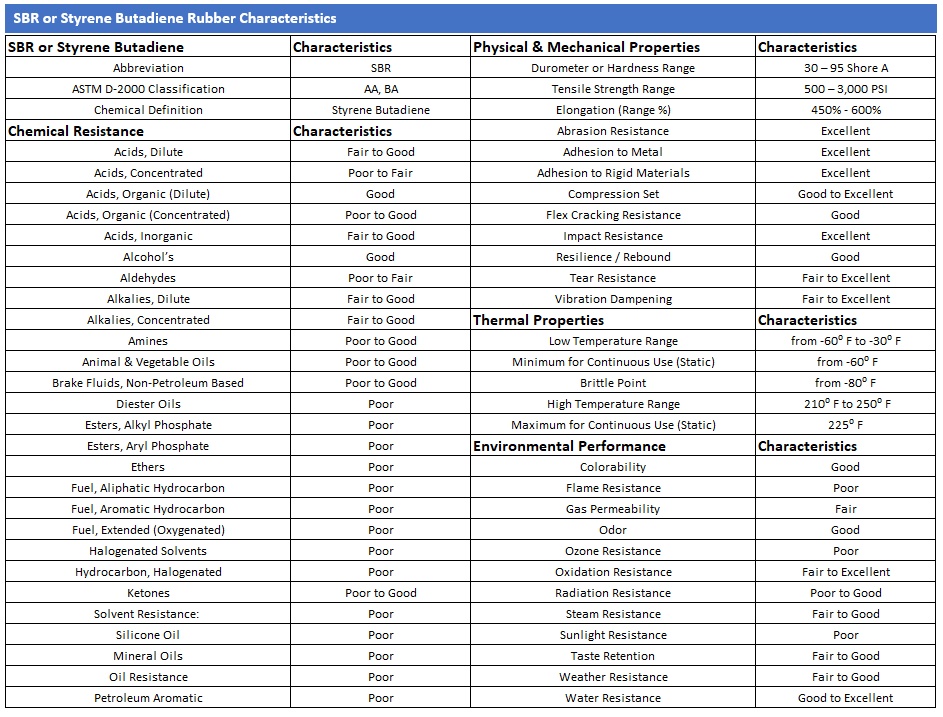SBR - Styrene Butadiene Rubber
What is SBR?
SBR is the most commonly produced synthetic elastomer worldwide, with a high production volume. This type of elastomer can be synthesized through the process of solution and emulsion polymerization of styrene and butadiene. Two different temperatures can be used for free radical emulsion polymerization 50°C (called hot emulsion) and 5-10°C (called cold emulsion). Both processes use different initiators, such as potassium peroxydisulfate and redox initiator respectively. The glass transition temperature (Tg) of SBR, which ranges from (-55 to -35°C), depends on the ratio of styrene to butadiene used in the polymerization process. Additionally, the density of SBR is 0.94 g/cm3.
Different grades of SBR:
- 1000: Hot emulsion SBR
- 1500: Cold emulsion SBR
- 1600: Cold emulsion SBR, masterbatches with 14 phr or less oil
- 1700: Cold emulsion SBR, oil masterbatches
- 1800: Cold emulsion SBR, oil-carbon black masterbatches with more than 14 phr oil
- 1900: Emulsion resin rubber masterbatches.
Solution SBR differs from emulsion polymerization SBR in that it has a narrower molecular weight distribution, higher molecular weight, and a higher content of cis-1,4-polybutadiene. The hot emulsion SBR is more branched compared to the cold emulsion SBR. Cold SBR, on the other hand, exhibits superior abrasion resistance and dynamic properties. SBR has the advantage of imparting higher filler loading, better resistance to flex fatigue, and higher resistance to abrasion at higher speeds, although it has lower reversion resistance. However, SBR does have some drawbacks, such as inferior mechanical properties in its neat form, poor ozone resistance, and poor oil resistance. To cure SBR, sulfur, sulfur donor systems, or peroxide systems can be used.
Rubber, Chemicals & Compounding
SBR (Styrene Butadiene Rubber) is typically sold in lower viscosity grades than NR (Natural Rubber). This allows it to be used in rubber compounding without the need for premastication, mechanical or chemical peptizing. While SBR has properties comparable to NR in most respects, it is inferior in some aspects such as heat build up, tack and gum tensile strength. However, the addition of resins and reinforcing fillers can significantly improve these properties.
SBR has an irregular molecular structure, which makes it unable to crystallize. Therefore, reinforcing fillers are necessary to achieve good physical properties. Among these fillers, carbon black is the best option, as other fillers tend to very inferior properties in SBR compared to a natural rubber compound. SBR is better than NR in terms of resistance to abrasion and heat degradation, but it requires more accelerators to cure because it is less chemically reactive. Scorch problems are less likely to occur with SBR than NR, especially in carbon-filled compounds. SBR is compatible with NR, butadiene rubbers, EPDM (ethylene-propylene terpolymer), nitrile, and chloroprene rubbers. The sulfur accelerator ratio has a similar effect on cross-link distribution in SBR as it does in NR. Typically, a lower sulfur level and a higher accelerator level are used for SBR cure systems.
The development of strong adhesive properties, known as building tack, can be enhanced in rubber compounds by either incorporating tackifying resins or by blending with natural rubber. Plasticizers of the petroleum and coal-tar variety are utilized to facilitate processing and decrease expenses.
Solution-polymerized SBRs are typically pricier compared to their emulsion counterparts, and hence are applied in specialty applications that require a higher glass transition temperature (Tg) and superior grip while in contact with fluids. These properties are particularly advantageous in the production of high-performance rotary seals.
Advantages of SBR Rubber
SBR rubber has excellent properties as mention below:
- Excellent abrasion resistance
- Good tear resistance
- High electrical resistance
- Good crack resistance
- Low compression set
- Better heat resistance than natural rubber
- Resistant to non-petroleum-based fluids like alcohols, water, grease, etc.
- Odor resistant
Disadvantages of SBR Rubber
SBR rubber has disadvantages similar to natural rubber:
- Poor resistance to petroleum oils and fuel
- Poor resistance to ozone and weather
- Low tensile strength
SBR or Styrene Butadiene Characteristics
